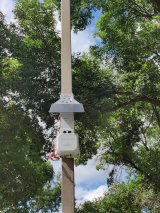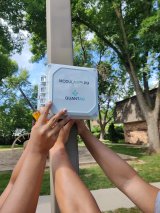Madison, Wisconsin
Air Monitoring Grant Update
|
Pollutant(s) of Interest |
PM2.5, and PM10 |
|---|---|
|
Primary Objective |
Install a city-wide network of air quality sensors to provide real-time, ground-level, publicly accessible information on particulate matter pollution at the neighborhood scale, engaging community members to raise awareness about the connections between air quality and health, and ensure that community input is reflected in project design and deliverables. Network data will help characterize the spatial distribution of PM pollution across the city, identify neighborhoods experiencing the greatest levels of PM air pollution, enable work with the community to determine next steps for improving air quality and protecting the health of residents. |
|
# of New Devices |
70 |
|
Monitoring Device(s) |
MODULAIR-PM sensors |
|
Primary grantee contact |
Office of the Mayor, City of Madison |
|
Key grant partners |
University of Wisconsin at Madison; Public Health Madison and Dane County; Foundation for Black Women’s Wellness; Latino Health Council; The Hmong Institute |
|
More Information |
https://www.cityofmadison.com/sustainability/climate/air-quality |
While the state capital of Madison, Wisconsin already gathers air quality data from its two regulatory monitoring sites, the small Midwest city was looking for more block-level air quality information, particularly in communities with environmental justice concerns. The city of Madison is using a $429,746 EPA IRA grant to strategically partner with three area non-profits— The Latino Health Council, The Foundation for Black Women’s Wellness, and The Hmong Institute—to connect with Madison’s constituencies most likely to be affected by respiratory illness. The project aims include activating, educating, and informing residents all over the city on the importance of air quality data and how to interpret it, while deploying a vast network of nearly 70 solar powered air sensors in every census tract in the community in order to gather information.

Courtesy of City of Madison
Through a robust public engagement effort, the team first identified the general areas residents wanted to see additional air monitoring—schools, homes, bus stops, parks, and health care facilities. Next, project leaders are working with community members at the neighborhood level to determine the specific placement for dozens of air sensors, responding to individual requests and locating areas where satellite data shows an increase in bad air quality days and wildfire smoke. As sensors are deployed, the team will host community engagement information sessions to teach residents about how to interpret air quality data and use it to inform decisions about daily life. This type of community engagement and information gathering will continue into 2025 as the network collects four season data and identifies air quality trends.
The ultimate goal of the project is to make this data accessible. While the city sees Madison’s residents are the primary beneficiaries of this data, they realize that there are

Courtesy of City of Madison
other audiences, too. Academic partners at University of Wisconsin, public policy makers, neighboring communities and even technology and app developers may find value in a deeper understanding of air quality in Madison’s central core. This data will be used for everything from local decision making on traffic patterns to a nationwide NASA-run database of air monitoring networks around the country. The city sees data access as the key to tackling environmental justice issues across the city, the region and the state.
